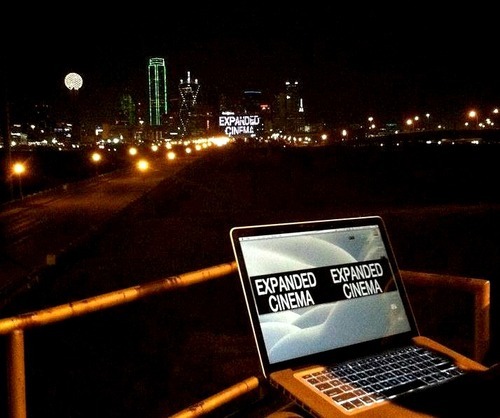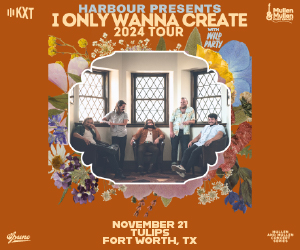
SIMULCAST AIRS ON KXT 91.7 – WEDNESDAY, SEPTEMBER 26 at 8PM
By Jerome Weeks – The Dallas VideoFest will mark its 25th anniversary Wednesday in a very big way. It’ll use the 20-story lighting display on the outside of the Omni Hotel to project videos. They’ll be seen for miles. KERA’s Jerome Weeks rode with coordinators of the event as they looked for the best viewing spot.
- Short videos of an early test
- KERA radio story:
[sounds of traffic zooming past]
It’s night along Riverfront Boulevard, and Bart Weiss is standing in the middle of the road. Weiss heads up the Dallas VideoFest. He’s scouting locations where the public might watch the artists’ videos, videos that’ll turn the Omni Hotel into a giant, experimental TV set.
Weiss: “This is to me is a kind of good distance. A little further, the images work a little bit better, but then the scale isn’t nearly as big. And that’s kind of the conundrum.”
The conundrum is caused by the Omni’s display system. It’s not a huge video screen like a Jumbotron. It’s made of long strings of LED lights that wrap around all four curvy sides of the building, one string for each of the hotel’s 20 stories. The LEDs change colors, turn on and off, acting like the pixels on a TV screen, forming moving images as they flicker.
But a high-def TV screen can have a million pixels. The Omni display has only 6,600 LEDs. Its image resolution is extremely low-res, easily blurred. If you’re standing too close — even three or four blocks away — you sometimes can’t make out the figures. Too far away, and the whole thing’s not very impressive.
[door slam] That’s why Weiss and video artist Carolyn Sortor [seat buckle noises] are driving around Oak Cliff in Weiss’ Mini Cooper trying to find a good site.
[traffic sounds, a chopper overhead, a woman laughing]
 It’s a clear, breezy evening, and some of the video artists have gathered along a Jefferson Viaduct entrance ramp on the south side of the Trinity to watch a test-run of their work. Pat Anderson’s here. Anderson works for Matthews Southwest, the company that runs the Omni. He’s notan artist. “I actually work more in accounting than this [laughs].” Even so, he was put in charge of the LED screens. Currently, the system runs generic animation software or company logos from firms attending conventions at the Omni. (That’s the stipulation for what can go up there: If event-related, it needs to be a downtown event, a city event or one the Omni’s connected to. And, of course, no nudity, no politics, no advertisements.)
It’s a clear, breezy evening, and some of the video artists have gathered along a Jefferson Viaduct entrance ramp on the south side of the Trinity to watch a test-run of their work. Pat Anderson’s here. Anderson works for Matthews Southwest, the company that runs the Omni. He’s notan artist. “I actually work more in accounting than this [laughs].” Even so, he was put in charge of the LED screens. Currently, the system runs generic animation software or company logos from firms attending conventions at the Omni. (That’s the stipulation for what can go up there: If event-related, it needs to be a downtown event, a city event or one the Omni’s connected to. And, of course, no nudity, no politics, no advertisements.)
In practice, what all that means is slow-moving, abstract graphics and lettering with sharp, bright colors. In May, when Weiss first talked to Anderson about the anniversary project, Anderson realized he’d be running actual video footage for the first time.
Anderson; “We know what the system’s capable of but we’ve never had this kind of output before. So this is all a new learning experience. Which is really one of the reasons I wanted to work with these guys.”
Other cities (and stadiums) have giant video displays, like the ones in New York’s Times Square. The artist Jenny Holzer has had work shown there, but for the most part, such screens run commercial programs — or footage of sporting events. The VideoFest celebration – it’s called Expanded Cinema – has 14 artists taking over the external display of an entire building, bigger than any billboard. Plus, the videos have their own soundtracks, which’ll be simulcast over KXT-FM, 91.7
 The Viaduct entrance ramp is actually a spot Anderson himself found months ago; he uses it for checking out the results of his work with the Omni. There, the artists watch and listen as a laptop plays their soundtracks (top image). One of the videos takes us back to the beginnings of digital displays: a super-sized game of Pong. Others — taking off on the imagery of TV ads and billboards — feature cascades of money and diamonds or colossal taglines and hrases (“Silence Exile Cunning”).
The Viaduct entrance ramp is actually a spot Anderson himself found months ago; he uses it for checking out the results of his work with the Omni. There, the artists watch and listen as a laptop plays their soundtracks (top image). One of the videos takes us back to the beginnings of digital displays: a super-sized game of Pong. Others — taking off on the imagery of TV ads and billboards — feature cascades of money and diamonds or colossal taglines and hrases (“Silence Exile Cunning”).
Different kinds of codes — Braille and Morse — appear in some, while images of eyes and eyeballs, seeing and being seen, pop up in others. Artist Rebecca Carter (with Mark Collop) fills the Omni’s surface with dozens of looming cat’s eyes staring out at us (bottom). She calls the video The Eyeballs from Outer Space, and it’s characteristic of the work’s part-spooky, part-playful nature that it’s backed by “Strangers in the Night”(“strangers in the night exchanging glances”).
For his work, artist Jeff Gibbons uses a loop of an old home video that captured his uninhibited, ‘happy dance’ at age 9 (above, left). Frank Campagna goes for bold colors and shapes: He sends images of apples, oranges and bananas slowly scrolling past, like the dream of a gargantuan fruit vendor.
The videos can seem eerie or whispy, particularly when seen at a distance without their soundtracks — silent ghosts flickering among the city towers. Even with their soundtracks, some videos fizzle, too easy or too inscrutable, perhaps not energized by the skyline-changing ambition of the project but inhibited by it. Others acknowledge the size and setting to play with a Hollywood-scale stardom – the ultimate CinemaScope projection. Artist Mike Morris [bluesy instrumental version of ‘Autumn Leaves’ starts] employs the pop-psychedelic outline of a dancing woman (below). It’s actually a rare bit of the city’s underground history being displayed. Morris explains he used the silhouette of Candy Barr, the infamous exotic dancer and porn star from Dallas in the 1950s who eventually served time for marijuana possession.
 Morris: “I just thought it was appropriate to put her back on the surface of the city. Technically, the hotel is located only a few blocks from where the Colony Club was, where she danced.”
Morris: “I just thought it was appropriate to put her back on the surface of the city. Technically, the hotel is located only a few blocks from where the Colony Club was, where she danced.”
[car sounds] Back in the Mini Cooper –
Weiss: “All right, so our next place … is this lawn right here.”
– Weiss and Sortor find an open field at Jefferson and Colorado Boulevard that’s just what they need. If they can get the permissions, if they can get a generator to power audio speakers so people can hear the radio simulcast., if people will bring lawn chairs so they can sit.
Weiss: “I don’t know where we could park.”
Sortor: “This looks great. It could be awesome.”
Weiss: “All right.” [Hand brake clicks on, seat belt clicks open]
For Weiss, Expanded Cinema isn’t just an evening of video fireworks, a novelty event, an attention-getting stunt. It’s the future. He says older, pedestrian-friendly cities can be rich with street-level details and artistic touches. But like many post-war American cities, Dallas is a drive-by town, more freeway and suburban sprawl than urban grid and population density. It’s designed for quick impressions caught through a car window. So large-scale digital displays like this are a way artists could transform the city’s night-time architecture, make itrich with detail. Why leave it all to the neon signs for Denny’s and Citibank?
Weiss is even trying to swing a simultaneous response from Reunion Tower; the videos would make for a flashing rectangle in one corner of the skyline, the tower would be a glowing red circle.
Weiss: “Our real hope is if we can do this and then we could do other places where there are large screens, then I think the whole sense of landscape and how artists can intersect with that can really change.”






